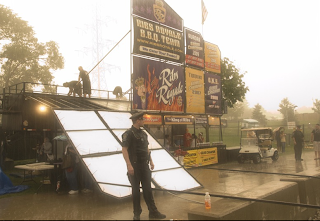
Okay, I didn't quite make it into print... but the electronic version isn't half-bad. I was working on the waterfront when, during one of those brief-but-violent thunderstorms, a sign fell onto the walkway, narrowly missing a number of pedestrians. So I got to stand in the rain to make sure no one else would get hurt until they managed to get the sign removed and the other reinforced.
Working with the police is a great experience 95% of the time. Even getting soaked in the rain just standing there has a charm of its own although most of the time it's just helping the public with questions and concerns. Halton is a pretty safe area so we don't have the problems of major urban centres; most evenings when I'm on duty the computer lists only a few calls through the night. The remaining 5% of the time is both depressing and disappointing -- people in serious trouble. But, we're there to help regardless of the perceptions of those involved. My only regret is that because our shifts are infrequent we don't get the closure on the situation that the regular officers do.
I always encourage teachers to get involved with their local Auxiliary; their most serious needs parallel our down times so they mesh well. And the skills and knowledge are something we don't often encountered in teaching. Check it out!
Comments